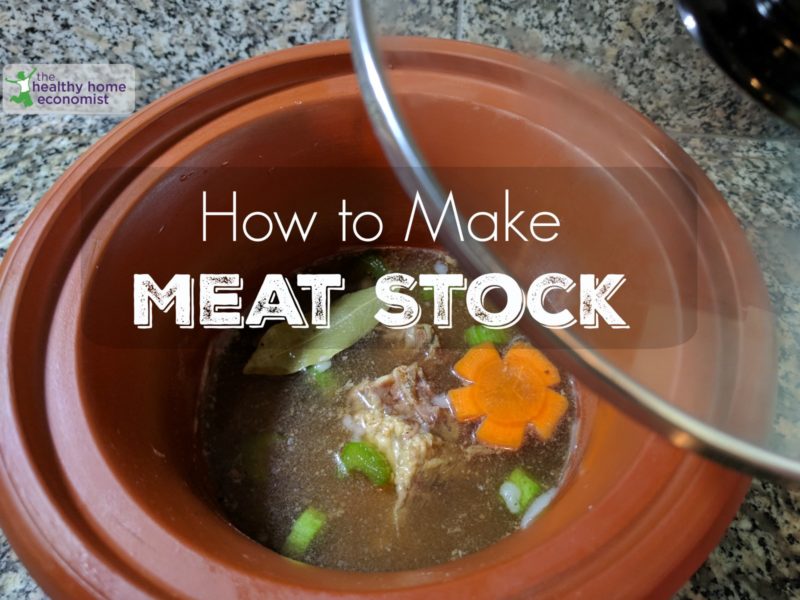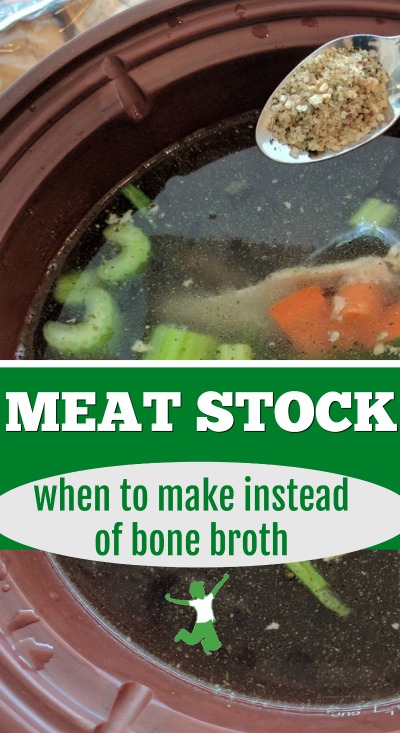Table of Contents[Hide][Show]

Properly prepared homemade broth is a foundational food for autoimmune healing diets such as GAPS, AIP, or the Specific Carbohydrate diet.
The GAPS protocol, for example, recommends a small cup of broth with every meal. This traditional food is the only cooked food that acts as a raw food when consumed. This is accomplished by the gelatin in the broth, which powerfully attracts digestive juices to itself. This, in turn, significantly enhances the nutrient absorption for all the other foods consumed with it.
Ironically, this most curative of foods is frequently not well tolerated by people with leaky gut – the very people who desperately need it! Fortunately, this intolerance only lasts a short period of time until gut-healing advances.
What to do in the interim since bone broth is such an important healing food? The answer is to make meat stock instead.
When Meat Stock is the Better Choice
The reason some individuals with leaky gut do not tolerate bone broth is is due to the beneficial natural glutamates that can sometimes trigger uncomfortable reactions. MSG is the synthetic, factory-produced version of glutamate. MSG is an excitotoxin, which means it damages or even kills neurons. Neurosurgeon Dr. Russell Blaylock MD lays out all the science in his eye-opening book Excitotoxins: The Taste that Kills.
While the natural glutamate in bone broth are not dangerous or equivalent in any way to concentrated, factory-produced MSG, they can nonetheless trigger similar symptoms in sensitive individuals. Yeast extract can do the same. Thus, anyone sensitive to MSG typically does much better with meat stock, which has little glutamate by comparison.
Others best served by stock instead of broth are children and adults who are autistic, those with ADD/ADHD, and/or people suffering from seizures or tics.
Another sign that bone broth is best replaced with meat stock is when uncomfortable die-off symptoms, as well as nervous system agitation occurs. These are signs that your digestive tract is not ready for bone broth. Use meat stock when symptoms such as diarrhea, vomiting, nausea, constipation, and skin eruptions or rashes develop. Making the transition gradually from stock to broth is advisable.
Storing Meat Stock
When you make meat stock as described in the recipe below, you will notice that a significant amount of fat forms with it. This fat is best left in the stock. When it cools, it will rise to the top and remain there. The fat forms a protective seal that prevents oxidation.
Refrigerated meat stock will last a week or more with that layer of fat on top. If you prefer to remove the fat to create a clarified meat stock, it is best to freeze it. No worries, as meat stock thaws beautifully.
This article on freezing stock or broth provides tips on the safe use of either plastic or glass for this purpose.
Homemade Meat Stock
The most significant difference between meat stock and bone broth is that stock is not cooked as long as broth. This results in some pros as well as cons.
Pros
First for the pros. Stock is just as rich in gelatin and beneficial detoxifying amino acids (like proline and glycine) as broth. These nutrients are pulled out of the meat and connective tissue during the first several hours of cooking. A lengthy simmer is not necessary.
Another pro is that the meat used to make stock doesn’t become tasteless as it does with a long-simmering broth. It is delicious and can be used alone or with any meat dish you wish.
Cons
Now for the cons. First, you will notice that stock is not quite as flavorful as long-simmering bone broth. This is due to the significant reduction in glutamate.
The savvy home chef can compensate by ensuring quality vegetables are simmered with the meat stock. While making bone broth doesn’t always require vegetables to achieve amazing flavor, meat stock definitely does. If you don’t have time to add veggies to your stock, check out this article on seasoning stock to ensure it is great tasting anyway.
I would recommend following the recipe below as closely as possible to ensure your stock tastes as flavorful as properly made broth. Using chicken feet is highly recommended as well (though an optional ingredient) to achieve higher levels of gelatin.
Avoid Stainless Steel
I recommend avoiding stainless steel pots and pressure cookers like the Instapot for making both meat stock and bone broth.
This is due to the very real potential for leaching heavy metals like nickel when acidic dishes are cooked. Enameled stockpots or the clay slow cookers like Vita-clay would be safer choices. This is especially important for those already suffering from heavy metal toxicity issues. This risk has been demonstrated by compelling scientific research.
How to Use
Meat stock is a wonderful base for soups and sauces just the same as broth.
Sipping it on its own in a mug is delicious and hugely beneficial too, especially when added to a meal of other cooked foods.

Homemade Meat Stock Recipe
Recipe for gelatin rich meat stock to be used instead of bone broth for those with leaky gut in the beginning stages of healing.
Ingredients
- 1 whole chicken preferably pastured
- 2-4 chicken feet optional
- 1-2 chicken heads optional
- 4 quarts filtered water
- 2 Tbl apple cider vinegar raw, packed in glass only
- 1-2 yellow onions medium, preferably organic
- 2-4 carrots preferably organic
- 3-4 celery stalks preferably organic
- 1 bay leaf
- 1-2 tsp sea salt
- 1 bunch parsley preferably organic
Instructions
-
Rinse chicken and optional feet with filtered water.
-
Cut whole chicken in half down the middle lengthwise. Place everything in the stockpot. Add remaining ingredients.
-
Fill pot with filtered water. Allow the pot and its contents to stand for 30 minutes, giving the raw apple cider vinegar time to draw minerals out of the bones. Bring to a boil. Reduce the heat to a simmer and cook for no more than 1 ½ to 2 hours.
-
Add parsley and sea salt during the last 10 minutes of cooking. Remove the chicken and other large parts. Debone and reserve the meat for eating. It will be delicious.
-
Strain the stock, cool to room temperature and then refrigerate or freeze.









You’re amazing, thanks so much!!
Another question! Would brining the chicken change anything in the broth? Besides not adding salt at the end. Boiled chicken is just ???? …brining it first would improve the taste and texture so much!
Yes, you can brine the chicken first if you like. Here’s more info on both dry and wet brining. https://www.thehealthyhomeeconomist.com/dry-brining-complete-guide/
https://www.thehealthyhomeeconomist.com/turkey-brine-recipe-healthy-toxin-free/
I have a child with sensitivity to apples. Would a different vinegar be ok to use? Or, with just 2 tablespoons..maybe it will be ok? We are trying to heal eczema. Thanks!
You can use wine vinegar or rice vinegar instead of ACV if you like. I don’t like to suggest white vinegar as it is usually of GMO origin.
How long and what temperature can you cook the meat stock in a crockpot? Thanks
I don’t use a crockpot so cannot offer any advice here.
Hi Sarah, I’m wondering which I should use in my homemade liver based baby formula, bone broth or meat stock? I have the GAPS book and she suggests starting baby on meat stock as their first food. I also noticed that the Westin A Price liver formula recipe calls for broth. I’m looking to transition my 6 month old off of commercial hypoallergenic formula and I’m needing a little clarification.
Bone broth is more nutritious, so go with that if baby tolerates it. Most do just fine.
What do you do with the chicken when finished? What do you make with it? Amy suggestions? We aren’t huge meat eaters, we only like breast
Chicken salad is great with the cooked meat.
Does anyone know how long this clay pot lasts ?
I’m looking to invest in one but all the literature suggests buying insurance for it ???
I’ve had one for 2 and a half years now and it looks brand new … I use it 2-3 times every week.
Hi Sarah, and thank you for your wonderful informative articles! I am buying a Vitclay pot, for my broths. Will they be able to cook both stocks and broths? I find it easier to just add the bones, and just to get the taste of the bones, so I guess it depends on personal taste?
Yes, you can do both bone broth and meat stock in a Vita-Clay. I do it all the time (twice weekly in fact 🙂
Hi Sarah, Thank you for clarifying this. Bone broth seems to give me a headache and I’ve wondered if it is the glutamate.
What are your thoughts on preparing the stock in a slow cooker? If that is a good option, what would be the recommended timing?
Yes, the glutamates can give some folks a headache. The good news is that this is usually temporary until gut healing has progressed.
I use a Vita-Clay slow cooker to make meat stock. It takes about 3-4 hours to make beef or chicken meat stock. I will be posting a recipe very soon. Be careful not to use stainless steel slow cookers as the slightly acidic meat stock can leech heavy metals. Best to use an enameled pot or clay or enameled slow cookers.
Hi Sarah,
Thanks so much for replying. My Son has had some falls as well and we have just taken him to see a chiropractor and his C1 and C2 bones were out.
We are going to keep with under chiropractor care and watch for improvement. Dr Natasha Campbell Mcbride said this too about bone broth with children on the Autism Spectrum.
I am a bit scared to try the meat stock at the moment and may wait a bit to see. I also did not realise the longer you leave the broth or meat protein in the fridge the glutemate gets higher which is a worry also. So now I only keep enough for a day and freeze the rest of protein.
Best wishes
Tracey